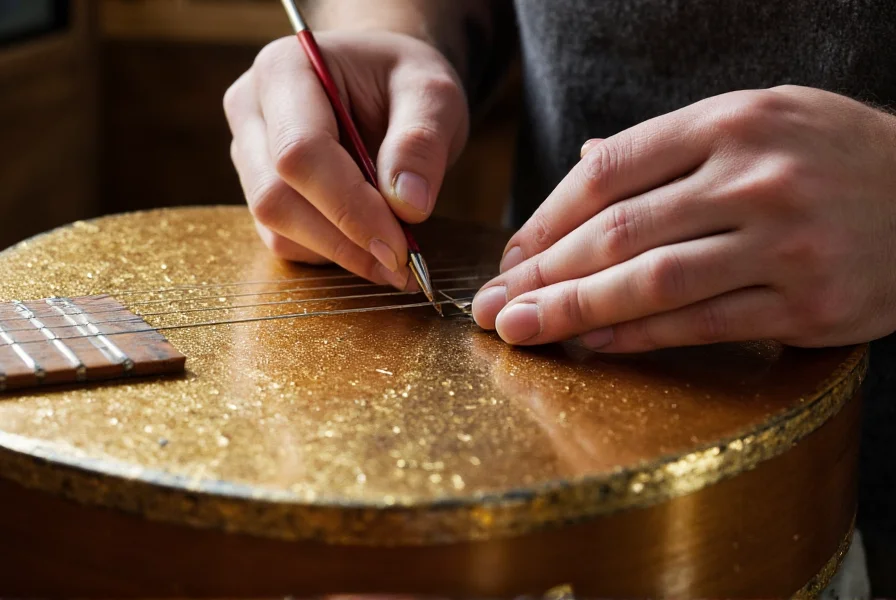When researching golmorich instruments, you're exploring a fascinating niche within classical guitar history. These distinctive instruments represent more than just musical tools—they embody a specific decorative tradition that flourished during the Romantic period of guitar making.
The Historical Origins of Gold Morich Guitars
The term "Gold Morich" (sometimes spelled "golmorich" in contemporary searches) refers to a specialized decorative technique developed primarily in Spain during the early to mid-19th century. The "morich" portion of the name derives from the Spanish word "morisco," referencing the Moorish influence on Iberian decorative arts. Luthiers would apply intricate gold leaf patterns onto the soundboard of classical guitars, creating instruments that were as visually stunning as they were sonically capable.
These instruments gained particular prominence through makers like José Ramírez I and Antonio de Torres Jurado, though the technique was employed by several Spanish workshops. The gold leaf decoration typically featured geometric patterns, floral motifs, or even elaborate scenes that reflected the Romantic aesthetic of the period.
Distinctive Features of Authentic Gold Morich Guitars
Understanding what makes a genuine Gold Morich classical guitar requires attention to several key characteristics:
| Feature | Description | Significance |
|---|---|---|
| Gold Leaf Application | Thin gold sheets applied in intricate patterns | Distinguishes from painted or printed decorations |
| Soundboard Material | Typically European spruce | Affects both visual contrast and tonal quality |
| Construction Period | Mainly 1820-1870 | Helps authenticate genuine historical pieces |
| Builder's Mark | Often includes maker's label or signature | Crucial for verification of authenticity |
Modern luthiers occasionally create contemporary Gold Morich style guitars, though these represent revival efforts rather than direct continuations of the historical tradition. These modern interpretations maintain the visual aesthetic while often incorporating updated construction techniques.
Evaluating Gold Morich Guitar Quality and Value
When assessing either historical or contemporary golmorich guitar craftsmanship, several factors determine quality and value:
- Authenticity verification - For antique instruments, documentation and provenance are critical
- Condition of gold leaf - Original, well-preserved decoration significantly increases value
- Sonic characteristics - Despite their visual focus, these instruments must still perform as quality musical tools
- Builder reputation - Instruments from known historical makers command premium prices
Collectors seeking where to find authentic Gold Morich guitars should consult specialized classical guitar dealers, major auction houses with musical instrument departments, or established luthiers who specialize in historical reproductions. The market for genuine antique Gold Morich instruments remains relatively small but dedicated.
Gold Morich in Contemporary Guitar Making
While the original Gold Morich tradition has largely faded, its influence persists. Several contemporary luthiers have revived the technique, creating instruments that honor the historical aesthetic while incorporating modern acoustic understanding. These modern Gold Morich style guitars often appeal to performers seeking instruments with distinctive visual presence for stage performance.
Understanding the difference between authentic historical pieces and modern interpretations is crucial for collectors and players alike. The most valuable instruments maintain both historical authenticity and excellent playing condition, representing the pinnacle of 19th century Spanish guitar craftsmanship with Gold Morich decoration.

Preservation Challenges for Gold Morich Instruments
Owners of Gold Morich guitars face unique preservation challenges. The delicate gold leaf decoration requires specialized care to prevent flaking or deterioration. Environmental factors like humidity fluctuations can particularly damage both the wood and the gold leaf application. Professional conservation of these instruments requires expertise in both musical instrument restoration and decorative arts preservation.
For those researching Gold Morich guitar restoration techniques, consultation with specialists in historical stringed instruments is essential. Improper restoration can significantly diminish both the monetary and historical value of these specialized instruments.
Conclusion
The Gold Morich guitar tradition represents a fascinating intersection of musical instrument craftsmanship and decorative arts. These instruments offer more than just their visual appeal—they provide a window into 19th century Spanish cultural aesthetics and the evolution of the classical guitar. Whether examining historical pieces or contemporary interpretations, understanding the specific characteristics of golmorich decorated instruments enhances appreciation for this specialized corner of guitar history. As interest in historical performance practices grows, these distinctive instruments continue to captivate both musicians and collectors seeking connections to guitar-making traditions of the past.










 浙公网安备
33010002000092号
浙公网安备
33010002000092号 浙B2-20120091-4
浙B2-20120091-4